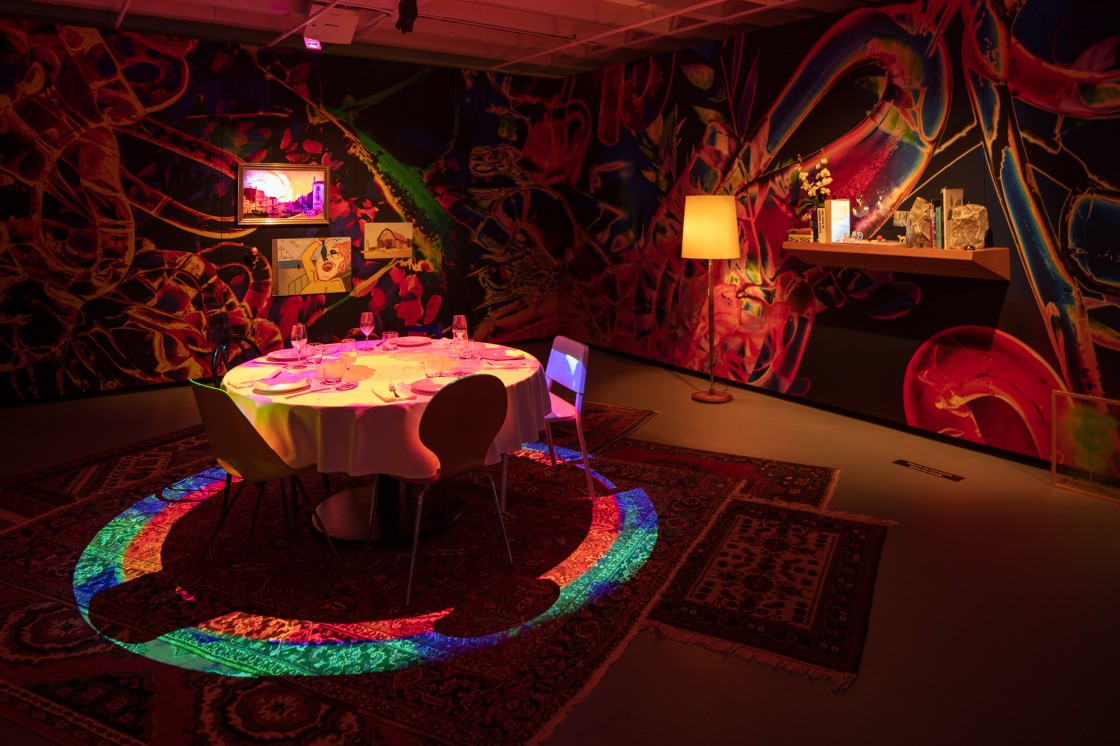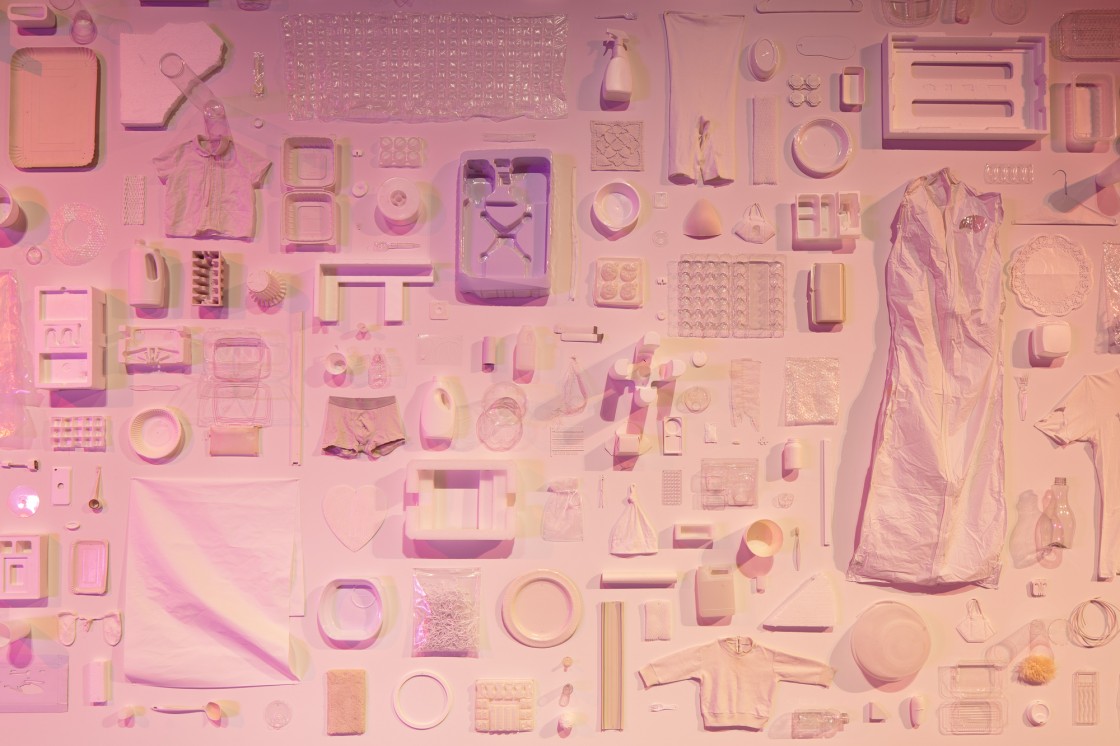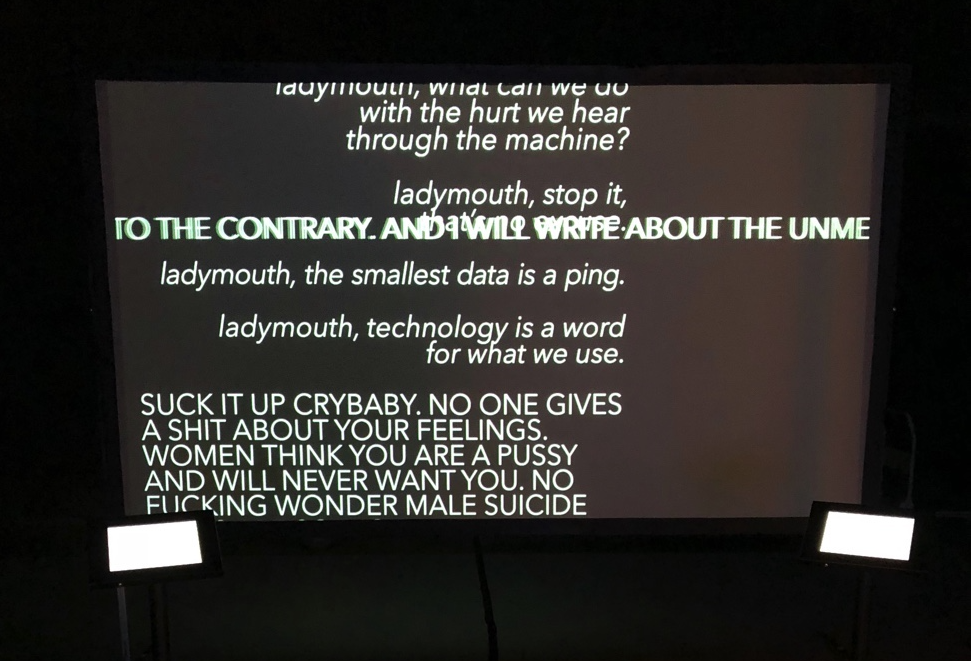Codes for (Un)Knowing
Coding.Care
“Act so that there is no use in a centre.”

Inside, the black box bursts with color. It’s a whole tiny world in there, a homunculus of meaning. A giant moon crashes into the bedroom and continues its orbit (“Pipilotti Rist: Big Heartedness, Be My Neighbor” n.d.). Pipi screams silently, reaching up from the floor, where she sinks within her tiny television. The flames behind her never quite engulf her, as if to say, memelike: This Is Fine.
I am writing again about trapped white women and problems of scale.
Pipi has arranged all the white things on the wall. All the white things are sorted and inert, aesthetically unnerving but pleasingly so. It is living as an algorithm to find and sort and display this way. I do it too.
It seems merely rote to sort what will be important and what will not be. But this is power. Here, on Pipi’s wall of white things, the criteria may seem obvious: white, or white-enough.
But the not-quite-whiteness of what’s not here holds up this wall with its exclusion.

This is about what is inside the black box, or moreso about what shores up its walls. “Black box” is a thought experiment and a shorthand for the unknown. No. Black box is presumed unknowable. It is enclosed as if it doesn’t need knowing.
Pipi, your rooms are joyful violations, written in slow motion, calling for tiny complete attention. You dress in a periwinkle dream and smash windows with a tropical flower (lesya Shats 2014).
You say color is a feminist statement. Perhaps that explains others’ obsession with black boxes. People just love the idea that there is ‘no way to know’ what’s inside. Like a black hole. Like a uterus. But a black box is not a black hole. A black box should not be where you put something you want to go away, something whose insides you want to ignore.
Their viscera make systems. They are hungry for data. That virtual assistant’s voice is the disembodied ghost of a sawed-in-half magician’s assistant who never made it out of that black box. She still wants to razzle-dazzle you, still wants to distract you.
Call it magic if you like.
Pipi, we are transfixed. We watch your videos lying down, touching just at the tops of our heads and at our hands, our legs splayed out in the museum’s ocean-floor dark. Pipi, your wicked game is riddled with ocean plastic and makes me giggle inappropriately. Everything processed through a black box will eventually sink to the bottom as indigestible trash. At least with black holes nothing comes back out. No IIIIIIIIIIIIIIIIIIIIIIII don’t wanna fall in love, Pipi shrieks, and I try to maintain the feeling that I do.
I was uneasy even then, but I didn’t listen. I misclassify my unease as fizz. Misclassification gets me every time. I make room for multiple meanings, a room for each meaning, like your staged rooms made too lovely to be lived in. We move in. The two of us sit on Pipi’s sofa and watch her boulder as if it is our TV. We move in like the pandemic will only last six weeks.
At some point I get stuck, and I put everything I have so far into the black box. This is what it outputs:
I want to be in a box, a flower, a body. I want to be a tiny white cube.
I want to be your body. I have a body. I have a body, a body that lives. I have a body that is alive and belongs to me. I have a body. I’m not even a woman. I’m not even a girl. I’m not even a girl. I’m a body.
Pipi, you are a box. You are a box of things. You are a box of words. You are a box of letters. You are a box of images. You are a box of feelings. You are a box of thoughts. You are a box of fantasies. You are a box of bodies. You are a box of voices. You are a box of bodies. You are a box of colors. You are a box of feelings. You are a box of bodies. You are a box of words. You are a box of stories.
Pipi, I’m your body. I’m not a body.
I’m a body.
I’m a body.
I’m a body.
I’m a body.
I’m a body.
I’m a body.
I’m a body.
I’m a body.
I’m a body.
I’m a body.
I’m a body.
I’m a body.
I’m a body.
I am writing again about bodies in boxes. The first black boxes held memory, trauma, relation:
“suppose I am in a friend’s house and, as a car goes past outside, his dog rushes to a corner of the room and cringes. To me the behaviour is causeless and inexplicable. Then my friend says, ‘He was run over by a car six months ago.’ The behaviour is now accounted for by reference to an event of six months ago. If we say that the dog shows ‘memory’ we refer to much the same fact—that his behaviour can be explained, not by reference to his state now but to what his state was six months ago. If one is not careful one says that the dog ‘has’ memory, and then thinks of the dog as having something, as he might have a patch of black hair.”
The ‘black box’ first appears in W. Ross Ashby’s book An Introduction to Cybernetics in 1956. For Ashby, black boxes are like memory, an observed explanation, relational: “to invoke ‘memory’ in a system as an explanation of its behaviour is equivalent to declaring that one cannot observe the system completely” (Ashby 1956).
In Ashby’s other colorful examples of black boxes, an engineer examines a broken bomb sight, a small child learns to open a door, and an object “has just fallen from a Flying Saucer” (Ashby 1956). Bombs, children, animals, and aliens become the proving grounds where current concepts of ‘artificial intelligence’ emerge. So much violence is built in to the black box from the start. Ashby says, “we have in fact been operating with Black Boxes all our lives,” and, “real objects are in fact all Black Boxes” (Ashby 1956). All I hear is trauma, trauma, trauma. Borders, borders, walls, walls.
How does a model hold memory? I used to hold memory just like a black box: act on it, try not to know what’s inside.
The first theft was ownership, and the first object of ownership was the body, say Fred Moten and Stefano Harney. “Ownership was a feedback loop. The more you own the more you own yourself.” They say the enlightenment produced “a science of loss, which is to say the science of whiteness, or, logistics” (Harney and Moten 2021). Pipi, do you know this science? Were you raised on it like I was? Your wall of white objects assures that everything is clean, pinned, silent, plucked from its context.
My father keeps everything so that he never loses anything. He never uses anything so that it never breaks. He says, “Don’t own anything, then you won’t have to move it.” He means, “Don’t love anything more than it loves you.” His exact words are “The person who cares more loses.” This is how I learned loss prevention. I learned early and it stuck. I learned it did not work, but I practice it anyway. He says, “Do as I say, not as I do.” But I don’t.
This is black box living, the refusal to know in any way that might know you back.
I am trying to accept the risk of knowing. Let grief be a marker of having known. Call this the difference between touching and holding. Touching shares, holding clings. Touching undoes the body, loses the self (or the illusion there ever was one). Touching textures you back.
To make memory, take rubbings of surfaces. Press or rub one thing against another thing, and whichever thing is harder transfers its texture, making an impression in the softer thing. A pattern appears only where they touch. And in return, the softer thing transfers its particles, marking the harder thing back. This is a form of relief.
But rubbing also removes. My shower is a white cube where I rub the skin to remove the skin. So much sloughs off. So much refuses. Memory also removes this way. So much sloughs off.
The residual is what’s left. Between a prediction (an expected result) and a prediction (a model’s output) is error. Error is measured by various functions for ‘loss’. These loss functions tell you how wrong you are, how far off your attempt.
Loss functions as an instructive, if you let it. “Each time my heart is broken it makes me feel more adventurous,” says Frank O’Hara. I keep practicing to let this be true.
“how we evade ownership/equilibrium is precisely in that refusal to prevent loss we call sharing, rubbing, empathy, hapticality: the undercommon love of flesh, our essential omnicentric or anacentric eccentricity. Everything, in the wake of such disordering, is loss prevention.” (Harney and Moten 2021)
What can be generated with/in this residual, this what-is-left which is a “refusal to prevent loss”?
In logistics, ‘loss’ refers to what is stolen and ‘prevention’ how to get it back. Loss is ‘supply chain theft’ and is calculated as a cost. To calculate loss is to tuck it away. How much loss is a rounding error?
“Why is there more craving than there is in a mountain. This does not seem strange to an echo and more surely is in there not being a habit. Why is there so much useless suffering. Why is there.” (Stein 2014)
Instead of this black boxed “don’t own anything, don’t love anything,” I want to evade ownership in the way Moten and Harney mean. I want to share, feel, touch as an erosive force until I am lost. Let water reach every part and recede. Be the craving and the mountain. Call it excess instead of error.
There are other kinds of boxes, besides monotone cube abstractions. There are handcrafted cedar chests with dovetailed corners, with knitted sweaters and passed-down quilts inside. These boxes smell of family, both sour and sweet. Their handcarved joints splay out like tiny fans, no need for glue or nails. These boxes rely on the tension pulling them apart to hold them together.
Dovetailedness is a strategy.
When I made my first project writing code, I made a chatbot called ‘ladymouth’ that tried to explain feminism to misogynists online (Ciston 2019). I thought ladymouth would be like Pipilotti’s mouth, wet against the glass. I thought she could mouth silently into (and also become) a mawing void. I wanted a sea of fish mouths mawing; I made a grid of GIFs of my lips repeating, silent again. They mouthed the words of yet another poem about gender.


I wanted to treat ‘ladymouth’ like a black box, to shove everything inside her that I didn’t want to know about the horrible things being said on the internet about women and anyone othered. The black box doesn’t work this way. The box, in all its complex code, holding all its rage and color, requires tending.
I had to enter the box and learn its codes, in order to create with it. In doing so I began to care for it. I even began to care about the people being cruel to it. Ashby says that another system emerges along with the black box: “the experimenter is coupling himself to the Box, so that the two together form a system with feedback” (Ashby 1956). Thanks a lot, Ashby. I am tethered to all the black boxes making judgments that affect my dailiness. Turns out it’s me stuck in the box — magician’s assistant, thrown voice like Alexa — my head and legs peek out from its severed halves.
This Is Fine.

How much loss is normal? When his hallucinations start, my father sees an orange setting sun and a giant orb of tangled wires. He sees a large tapestry with tears that keep repairing. He says he doesn’t mind. He likes them fine and wants them to continue.
Large machine learning models are said to hallucinate when they recombine input data in strange ways, like misremembering. When models hallucinate, they “suffer from producing factually invalid statements,” both subjective opinions and unsupported objective statements (Dziri et al. 2022). It is a very human thing to do, to be subjective, to suffer.
“Why is there so much suffering. Why is there.” (Stein 2014)
“Hallucination symptoms may manifest as deficiencies in various vision-language tasks like judgment and description, or factual errors in different visual semantics, such as objects, attributes, and relations.” (Liu et al. 2024)
Why call machine learning errors hallucinations, symptoms, suffering. A model does not suffer. Though it may well contribute to suffering.
Techno-capitalists want to see suffering as opportunity. Maybe that’s what my father thinks too. IBM advertises, “hallucination offers a novel approach to artistic creation” (“What Are AI Hallucinations? | IBM” n.d.). Ashby sounds like an infomercial; he sounds like that guy who slaps duct tape on a boat he just sawed in half. He says,
“no skill is called for! We are assuming, remember, that nothing is known about the Box, and when this is so the method of making merely random variations […] is as defensible as any other method, for no facts yet exist.” (Ashby 1956)
No facts yet exist — that’s easy for him to say, when he’s decided to assume from the start that nothing is known, nor can be.
This is not fine.
Pipi, can you please smash the window of this hot-boxed black box with a flower already?
Black boxes don’t just declare a zone of, “I don’t know.” Worse, they proclaim, “I don’t want to know.” They manufacture an ‘unknowability’ at the outset that they then use as justification not to investigate further. When I black box you, I claim the privilege to know you only by your interface. I choose the surfaces I want to interact with, the parts that are of use to me, the parameters I want to adjust. I get to choose what not to care about.
This is an unsustainable choice. The black box doesn’t know the point is not to prevent loss.
Even if it were, I cannot prevent loss. Neither can you.
I am angry; I want to skip the suffering, yours and mine.
I try to solve it, find an equation complex enough to predict it exactly. If I cannot prevent loss I want [to skip it, accelerate it].
No. I don’t want to prevent loss but to accelerate it. This is yet another kind of prevention, trying to [quell/quit/muffle] suffering rather than staying [connected] through pain and fear and change and unknowing.
“A representation that admits uncertainty as part of its structure can improvise knowledge.” (Robertson 2012)
Large models cannot admit uncertainty; they aim to squelch it. Theirs is a mode of reduction that hardens and hoards. Even as I learned to live this way — still uncertainty emerges, loss cracks open, water seeps through, expanding the cracks.
“even to name something, is to wait for it in the place you think it will pass.” (Baraka 1966)
Yet uncertainty does not have to mean suffering. Loss does not.
Instead of hallucination, could we call upon systems that are “improvising knowledge.” That first acknowledge never having known in any authoritative, encapsulating way. Instead of claiming knowledge, they welcome knowledge in its teetering verb state — a sharing, haptic undercommon of un/knowing.
“I speak of the verb process, the doing, the coming into being, the at-the-time-of. Which is why we think there is particular value in live music, contemplating the artifact as it arrives, listening to it emerge. There it is. And There.” (Baraka 1966)
Far sweeter ways of knowing. Fizz and curiosity. Dovetailedness holding us together. All the rage and color and quilting and texture inside.
Pipi, you call your show “Big heartedness, be my neighbor.” I like that you don’t lay claims. When you could have declared, “be mine,” you ask only to be nearby (“Pipilotti Rist: Big Heartedness, Be My Neighbor” n.d.). I want to stay nearby. I can let unknowing texture me. I can write other functions.

References
–>